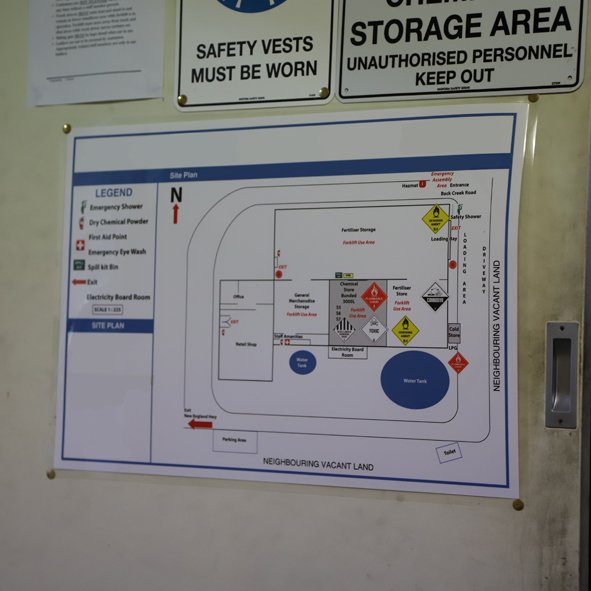Agsafe blog: Are your evacuation diagrams correctly displayed?
Importance of properly displayed evacuation diagrams
In any building, especially those that host hazardous materials, the correct display of evacuation diagrams is crucial. These diagrams are vital for ensuring that individuals can quickly and safely exit the premises in the event of an emergency such as a fire, chemical spill, or natural disaster. Compliance with Agsafe’s Industry Standards will help maximise safety and minimise risk.
Australian Standards for evacuation diagrams
According to Australian Standard AS 3745-2010, which governs the planning for emergencies in facilities, evacuation diagrams must be prominently displayed. These diagrams should be located at all exits and in other conspicuous locations along evacuation routes to ensure they are easily accessible and visible to everyone in the building. The standard outlines several key requirements:
Location and visibility: Evacuation diagrams must be positioned where they can be easily seen and understood by occupants. This means placing them at eye level, in the correct orientation and ensuring they are not obscured by furniture or other obstacles.
Content and clarity: Diagrams should include clear and concise instructions, marking all exits, emergency equipment, assembly areas, and evacuation routes. They should stand alone and not be used with traffic management plans or the general site plan. The use of universally recognised symbols and a consistent colour scheme is recommended to enhance comprehension.
Maintenance and updates: It is essential to regularly update evacuation diagrams to reflect any changes in the building layout or emergency procedures. Regular maintenance ensures that diagrams remain legible and relevant.
Agsafe's Industry Standards
As a leading provider of certification and training for the transport, storage and handling agricultural chemicals, we emphasise the importance of proper emergency planning. Our standards align with Australian regulations but also include industry specific considerations for facilities dealing with hazardous materials.
Hazard identification: Evacuation diagrams in Agsafe-approved facilities must clearly identify areas where hazardous chemicals are stored and outline specific evacuation procedures for those areas.
Special equipment: Diagrams should indicate the location of safety equipment such as eye wash stations, emergency showers, and spill kits, which are critical in facilities handling dangerous substances.
Training and drills: Agsafe standards stress the importance of regular training and evacuation drills to ensure that all staff are familiar with the evacuation procedures and can interpret the diagrams correctly under stress.
Managing compliance and safety
To ensure that evacuation diagrams comply with both Australian standards and Agsafe's industry guidelines, facility managers should conduct regular audits. These audits should verify that:
Diagrams are correctly positioned: Verify that diagrams are placed at all exits and other key locations, oriented correctly, standalone, and are unobstructed.
Content is accurate and up-to-date: Check that the information on the diagrams accurately reflects the current layout and emergency procedures of the building.
Visibility and legibility are maintained: Ensure that diagrams are clean, readable, and free from damage.
Conclusion
Properly displayed evacuation diagrams are a fundamental component of building safety, particularly in environments where hazardous materials are present. By adhering to Australian standards and Agsafe's industry-specific guidelines, facilities can ensure that their evacuation procedures are effective and that occupants can safely exit in an emergency. Regular audits, maintenance, and staff training are key to maintaining compliance and enhancing overall safety.

